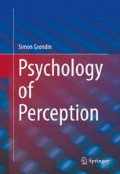Abstract
The purpose of this chapter is to explain the various ways to account for the capability to perceive form. The chapter includes a description of the notion of contours and a review of the factors influencing the perception of it. Then, the fundamental physiological process called lateral inhibition is described. This process helps understanding perceptual phenomena like the Mach bands. Another way of approaching form perception, the Gestalt approach, is then described, which includes the figure/ground distinction and the principles of perceptual grouping like similarity, proximity, and good continuation. Then, the theory of multiple spatial channels, which is based on the notion of spatial frequencies, is presented. This notion refers to the number of cycles (periods alternating between light luminance and dark luminance) per degree of visual angle. This theory leads to the contrast sensitivity function which describes the link between spatial frequency the perception threshold. Finally, perceiving a form requires recognizing it; the chapter also addresses this form recognition issue, describing the main approaches and models in the field.
Access this chapter
Tax calculation will be finalised at checkout
Purchases are for personal use only
References
Biederman, I. (1987). Recognition-by-components: A theory of human image understanding. Psychological Review, 94, 115–147.
Campbell, F. W., & Robson, J. G. (1968). Application of Fourier analysis to the visibility of gratings. Journal of Physiology, 197, 551–566.
Gibson, E. J., Schapiro, F., & Yonas, A. (1968). Confusion matrices for graphic patterns obtained with a latency measure. The analysis of reading skill: A program of basic and applied research. (Final Report, Project No. 5–1213). Ithaca, NY: Cornell University and U.S. Office of Education.
Ginsburg, A. P., Evans, D. W., Sekuler, R., & Harp, S. A. (1982). Contrast sensitivity predicts performance in aircraft simulators. American Journal of Optometry and Physiological Optics, 59, 105–109.
Hartline, H. K., & Ratliff, F. (1957). Inhibitory interaction of receptor units in the eye of limulus. Journal of General Physiology, 40, 357–376.
Hubel, D. H., & Wiesel, T. N. (1968). Receptive fields, binocular interaction, and functional architecture in monkey striate cortex. Journal of Physiology, 168, 215–243.
Marr, D. (1982). Vision: A computational investigation into the human representation and processing of visual information. New York: Freeman.
Marr, D., & Nishihara, H. K. (1978). Representation and recognition of the spatial organization of three-dimensional shapes. Proceedings of the Royal Society of London B, 200, 269–294.
Reed, S. K. (1982). Cognition: Theory and applications. Monterrey, CA: Brooks/Cole.
Selfridge, O. G. (1959). Pandemonium: A paradigm of learning. In D. V. Blake & A. M. Uttley (Eds.), The mechanization of thought processes (pp. 523–526). London: HM Stationery Office.
Tsao, D. Y., & Livingstone, M. S. (2008). Mechanisms of face perception. Annual Review of Neuroscience, 31, 411–437.
Werner, H. (1935). Studies on contour: I. Quantitative analysis. American Journal of Psychology, 47, 40–64.
Author information
Authors and Affiliations
Rights and permissions
Copyright information
© 2016 Springer International Publishing Switzerland
About this chapter
Cite this chapter
Grondin, S. (2016). Form Perception. In: Psychology of Perception. Springer, Cham. https://doi.org/10.1007/978-3-319-31791-5_6
Download citation
DOI: https://doi.org/10.1007/978-3-319-31791-5_6
Published:
Publisher Name: Springer, Cham
Print ISBN: 978-3-319-31789-2
Online ISBN: 978-3-319-31791-5
eBook Packages: Behavioral Science and PsychologyBehavioral Science and Psychology (R0)

